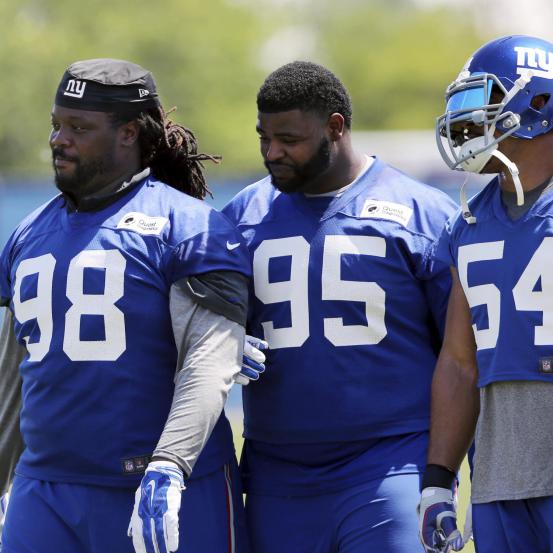- Commissioner’s statement on Ventura, Marte
- Ronnie O’Sullivan: Masters champion ‘felt so vulnerable’ in final
- Arron Fletcher Wins 2017 WSOP International Circuit Marrakech Main Event ($140,224)
- Smith challenges Warner to go big in India
- Moncada No. 1 on MLB Pipeline’s Top 10 2B Prospects list
- Braves land 2 on MLB Pipeline’s Top 10 2B Prospects list
- Kingery makes MLB Pipeline’s Top 10 2B Prospects list
- New Zealand wrap up 2-0 after Bangladesh implosion
- Mathews, Pradeep, Gunathilaka to return to Sri Lanka
- Elliott hopes for rain for Poli
Breaking Down the New York Giants’ Situation at Defensive Tackle
- Updated: May 26, 2016

Up next in my look at the New York Giants position units is defensive tackle.
2015 in Review
If “blech!” was the word for the defensive ends, then “ouch!” is probably the best word to describe the Giants defensive tackles in 2015.
Let’s start with Johnathan Hankins, the super-talented interior lineman who suffered a season-ending pectoral muscle in Week 9 against Tampa Bay.
Up until that point, it should be noted that Hankins’ production was nowhere near what it had been the year prior. Let’s take a look at that production through nine games.
Based on the table data above, Hankins pass rush success vanished in 2015 (along with the rest of his defensive line mates). With that, his ability to disrupt plays at or behind the line of scrimmage also fell off.
Why was this so? There are two possible reasons.
The first is an undisclosed upper body injury that Hankins might have been trying to play through until he suffered the pectoral tear.
The second and more tangible reason, though, is that when Hankins was at his best, he was lined up alongside of Jason Pierre-Paul.
Pierre-Paul, remember, didn’t return to the lineup until that Week 9 game, the same one where Hankins was knocked out of action. It would have been interesting to see if Hankins’ numbers would have picked up playing alongside of Pierre-Paul in those final seven games.
Let’s turn now to Cullen Jenkins who, thanks to the absence of Pierre-Paul, had to move from his defensive tackle spot to defensive end, a move made out of desperation when Owa Odighizuwa was battling his injury issues.
When Jenkins moved to defensive end, Markus Kuhn was often called upon to step in ahead of Jay Bromley. After bulking up to better hold up as the plugger inside, Kuhn’s struggles against solo blocking continued anyway.
With no one to draw double or triple teams inside, opponents had a field day in the running game. As previously noted in my breakdown of the defensive ends, the Giants finished 24th in run defense, allowing 121.4 yards per game.
Ouch indeed.
2016 Outlook: Where Can This Unit Improve?
Go grab a cup of coffee as we’re about to go back to a season that was pure magic for Giants fans, particularly those who were fans of strong defensive play.
The season was 2007, when rookie coordinator Steve Spagnuolo burst onto the scene with swagger and a bunch of ideas that helped transform a Giants defense that recorded just 32 sacks in 2006 into a quarterback-eating monster.
You remember that, right? The Giants went from 23rd in 2006 to first in the league in sacks, recording 54 in the regular season under Spagnuolo (and for good measure, added a league-leading eight sacks in the postseason).
Share Tweet
What was the secret?
Stopping the offense cold on first down (typically a running down) would force opposing offensive coordinators to abandon the run and go to the pass on second and third downs, when, of course, the pass rushers would do their thing.
History lesson over, but let’s see how it applies to last year and how the Giants need to improve as far as defensive tackle performance is concerned.
According to NFL Game Statistics and Information Systems (GSIS), the Giants run defense was abysmal on 1st-and-10 situations last year.
Opponents ran the ball 216 times against the Giants defense on 1st-and-10 in 2015. New York allowed 1,030 yards (seventh most in the NFL) on those plays, an average of 4.77 yards per play, with 23 of those rushes turning into first downs (13th most in the league). They also allowed an average of 6.09 yards per play on all first down plays, 31st in the league.
Also per NFL GSIS, opponents gained an average of 5.21 yards …
continue reading in source www.bleacherreport.com
